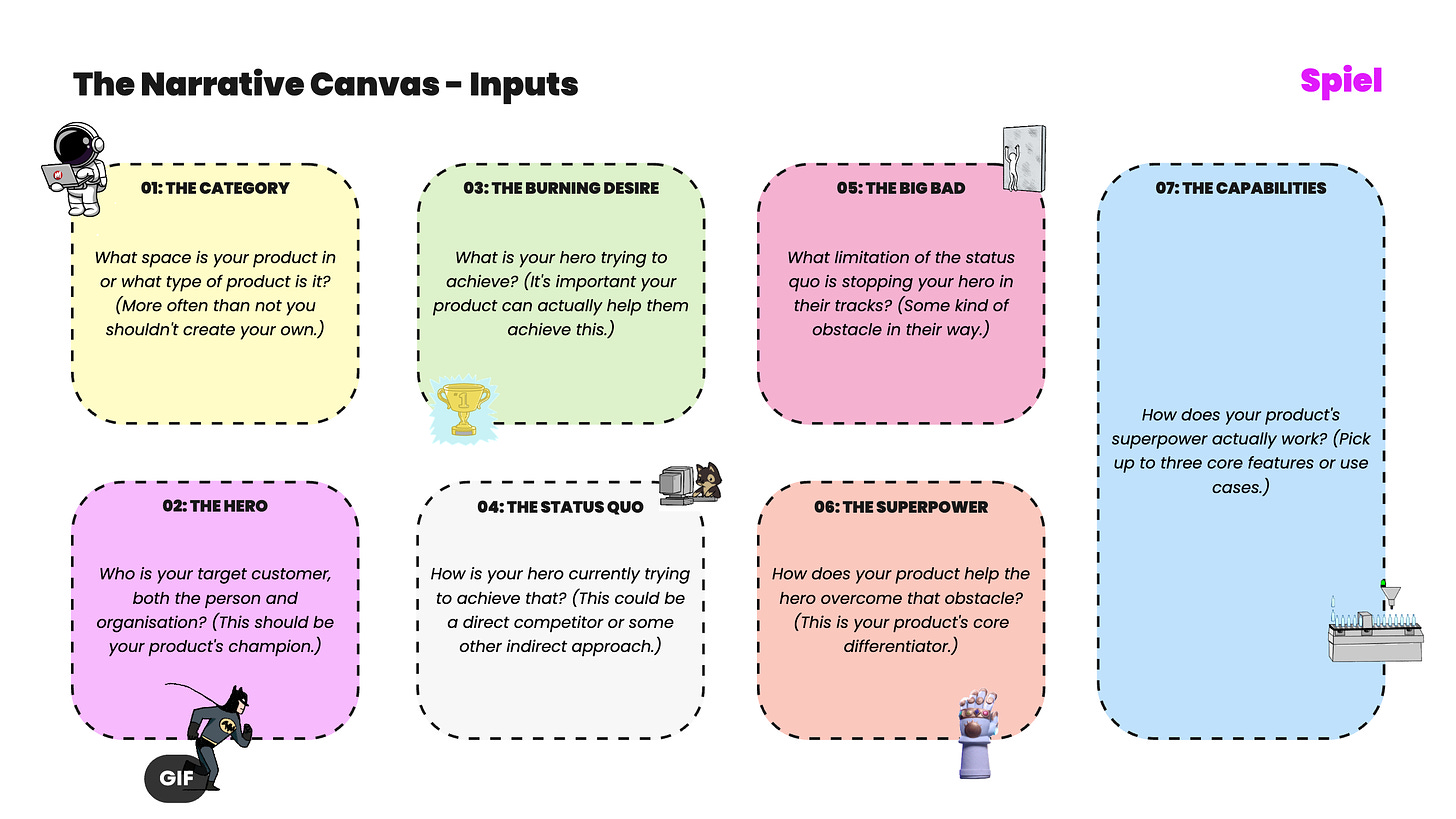One of the first questions I’m asked when talking about Narrative Positioning is, “How the hell did you get into my house in the middle of the night?”
After the initial screaming dies down, the second question is usually, “How do you actually use the narrative?”.
It’s a great question, because it highlights a really important point that all founders and PMMs should be aware of:
Strategy is useless if it’s not executed on.
You can conjure up the most genius narrative around your product. But if it only exists as an internal deck or one-pager or sticky note on your desk then it doesn’t matter.
It needs to be brought to life in some kind of outward-facing asset.
Generally, the main ones are:
Your website
Your sales deck
Your pitch deck
But hold your horses, cowboy, because your narrative needs to shift slightly depending on which of these you’re making.
Let’s take each in turn.
Oh, and best to familiarise yourself with the canvas before reading…
How your narrative lives on your website
Most of my client projects end with me writing their homepage messaging. For me, this is the key piece of marketing real estate. It’s also generally the most direct, like-for-like translation of the narrative we come up with.
It’s aimed at your buyers, obviously, and so the narrative needs to focus on the problem you’re solving for them.
In terms of my canvas, the key bits to focus in on for your homepage messaging are The Burning Desire, The Status Quo, and The Big Bad. All of these meet the buyer where they currently are and show that you just get them.
By evangelising the problem they’re facing, you get them on your side, and then your product becomes the obvious solution.
How your narrative lives in your sales deck
Whilst similar to your homepage given that it’s aimed at selling in your solution, a sales deck is slightly different to the homepage.
Chances are, once you’re sending a sales deck or walking them through it on a call, the buyer has already seen your homepage messaging. So they already get the gist of your narrative.
What you now need to do is tailor that narrative to their specific use case. Your salespeople should be able to find out exactly what this buyer is trying to achieve and why they can’t currently.
The sales deck is then designed to join the dots from the buyer’s specific hurdle, to The Big Bad of your narrative, before introducing The Superpower and The Capabilities, again tailoring each to your buyer.
So if the homepage and website is mostly about communicating your overarching narrative, your sales deck is much more focused on a specific way your buyer is experiencing the narrative.
How your narrative lives in your pitch deck
Out of the three, your pitch deck is a bit of an outlier. It’s aimed at investors, not buyers. And so that makes the way your embed your narrative a little different.
The key here is to raise the stakes of your narrative.
Normally you’d have very specific stakes. Your buyer is having trouble achieving something. Your product helps them achieve it. But investors don’t care as much about that. They want you to solve a problem not just at the customer level, but at a wider level.
To do this, you need to start with your hero-centric narrative and expand it out to either an industry-level or even society-level scope.
Here’s how I did it recently with a client who I was helping with their pitch deck:
As you work across from left to right, you see how we expanded the scope and scale of the narrative. It starts with how it impacts your buyer. Then moves on to how it impacts the industry. And finally how it impacts society at large.
For your pitch deck, you want to sit somewhere on the right-hand side of this spectrum. You could focus purely on the industry, purely on the society, or even mix the two together.
This is how you make it relatable to investors. In this example, investors don’t struggle with too much spent selling. But they definitely struggle with spammy sales tactics aimed at them.
The more relatable you make your pitch narrative for investors, the more they’ll sit up and take notice.
(On a slightly related note, I’ve just launched a new business. It’s called Deckheadz and we do Pitch Deck Reviews for tech startups. If you’re interested you can learn more at deckheadz.co.)
Another article done and dusted. Thanks so much for all the support so far. If you want to share this around with your friends, family, colleagues, pets then please do so. And if you haven’t yet subbed then now’s your chance.






